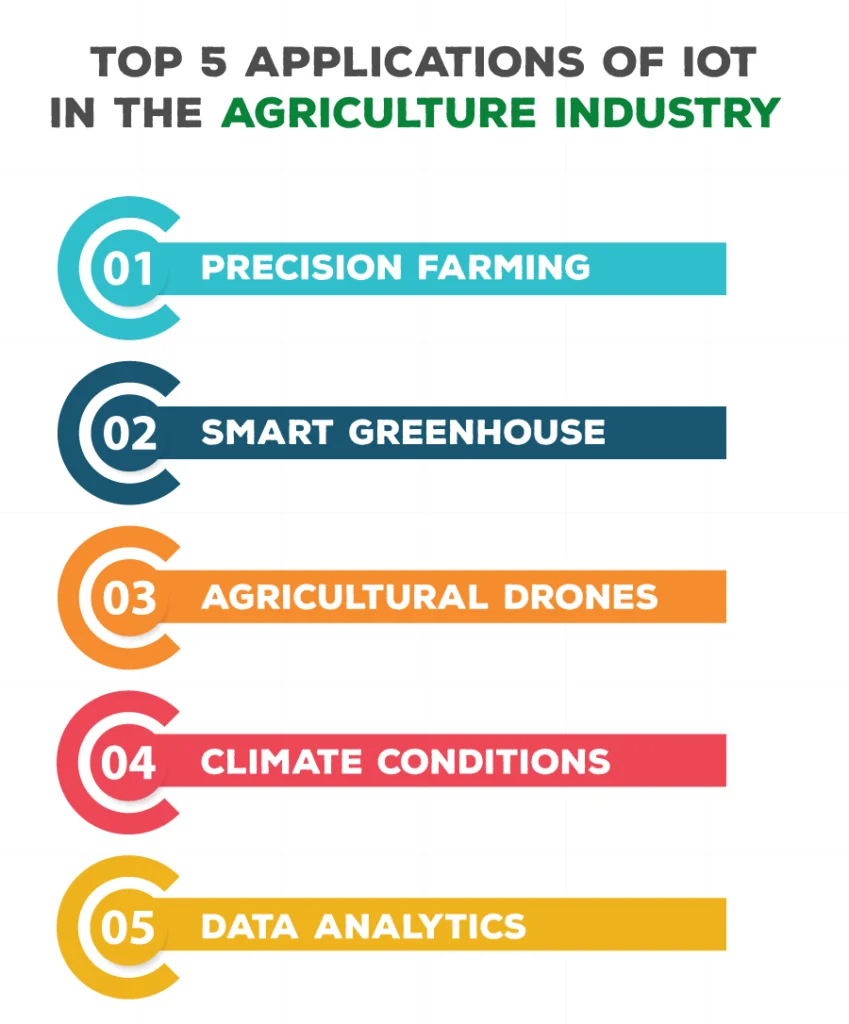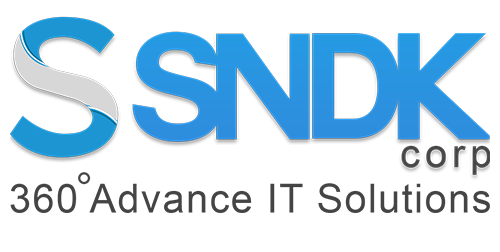IoT is meant to bring efficiency to the agricultural sector. It will create a cycle that will make food products more readily available to the consumers, will preserve the time and energy of farmers, will conserve the environment, and maintain sustainability.
Blog
5 Applications of IoT in Making Agriculture Industry Smarter
- Introduction of IoT – Helping Industries To Make a Smarter Environment
- Statistics of using IoT in the Agriculture industry
- How IoT took footprints of it in agriculture?
- Applicability of IoT in Agriculture
- Top-5 Applications of IoT in the Agriculture Industry
- Top-5 Benefits of Using IoT in the Agriculture Industry
- Conclusion
- FAQs
Introduction of IoT – Helping Industries To Make a Smarter Environment
Our environment is being exploited and polluted almost daily. Well, the technology goes through the same thing, advancing day by day, and it has been doing this for years. So, this smart sensor technology is helping to develop a greener world. The tech world can see IoT devices enhancing energy efficiency in homes as well as farms. Let’s dig into some of the ways IoT is helping in conserving the environment.
- One area where IoT has been used actively is the wildlife. It has been quite successful in bringing species back from the threshold of extinction. The IoT devices use collars, together with connected drones, for geo-mapping the animal’s habits and location. Wildlife experts and scientists find this less invasive, thereby being able to re-establish the species.
- Sensors have grown more than subtle than ever and can easily be carried and managed by people at ease. A wide variety of sensors can determine air quality and alert users through apps and smartphones at dangerous levels.
- Sensors can assist farmers in reducing the waste produced as well as monitoring the agricultural processes. They also regulate the amount of water used to hydrate crops when sensors are smart enough to explore the soil’s moisture level.
Statistics of using IoT in the Agriculture industry
It is anticipated that IoT is going to play a considerable role in increasing the ongoing agricultural productivity to cater to the growing food demand. The market size of IoT in agriculture was initially valued to be at $16,330 million in 2017. However, it is projected to reach $48,714 million by 2025. The global IoT in the agricultural market is predicted to grow at a CAGR of 14.7% from 2018 to 2025. It is due to reduced technology cost as a result of currently operating R&D in IoT and attempt by the government to boost the quantity and quality of agricultural production.
Few factors like the growing global population and increased demand for food across the globe, have resulted in the adoption of IoT technology to optimize agriculture production. The precision farming segment dominates IoT in the agriculture market in 2017 accounts for 44.7% of the overall market revenue. In 2017, it used IoT for field applications and farm equipment to gather data to analyze the data and optimize production.
How IoT took footprints of it in agriculture?
The world is in a need to produce at least 70% of more food by 2050. We all are aware that our agricultural lands are shrinking and our natural resources are exploited and depleted on a large scale, so the requirement to cater to the farm yield is a serious concern. Limited availability of natural resources like fresh water and cultivable land has contributing to slow crop yielding trends, thereby aggravating this problem even more. There has been a significant decline in agricultural labor as well, so adoption of Internet connectivity solutions has stepped up, reducing the need for a manual workforce.
IoT solutions are the ones that come into the picture to cater to the above agricultural problems. They are focused on helping farmers close the supply-demand gap by ensuring high yields, profit, and environmental conservation. The approach enforced here is to guarantee the optimum application of resources to attain higher crop yields and reduce operational costs, and this mechanism is known as precision agriculture.
Applicability of IoT in Agriculture
With the population across the globe growing at a very fast pace, agriculture must rise to meet the demand for food, regardless of the environmental challenges. The agriculture industry is bound to adopt new technologies such as IoT which has been very trending as of now. Smart farming and precision farming through IoT are allowing the agriculture industry to lower costs, reduce waste, enhance operational efficiency and improve yield quality. Smart farming is referred to as a hi-tech system of growing crops cleanly in a sustainable manner. This farming is built for monitoring field with sensors and automating the irrigation systems.
Top-5 Applications of IoT in the Agriculture Industry
IoT-enabled smart farming has promoted the entire agriculture system by monitoring the field and crops in real-time. The sensors and interconnectivity in IoT-based farming have succeeded in saving the time and energy of the farmers, most importantly reducing the extravagant needs of natural resources like electricity and water.

1. Precision farming:
Precision farming, being one of the most renowned IoT applications in agriculture, inhibits farming practices even more precise and controlled through vehicle tracking, field observation, livestock monitoring, and many more. These are some of the precision farming techniques, to name a few, which play a vital role in enhancing efficiency and effectiveness. The data is analyzed and interpreted by the sensors accordingly.
2. Smart greenhouse:
IoT has empowered weather stations to adjust the climate conditions automatically as per a certain set of instructions. The need for human intervention, therefore, has been alleviated completely, making the entire process accurate and cost-effective at the same time. The water consumption and greenhouse state are monitored via SMS or email alerts with the help of sensors.
3. Agricultural drones:
Agricultural drones is one of the trending application in this technological era. The Aerial and Ground drones are used for crop health assessment, crop spraying, planting, and many more. Drone technology has given a boost and makeover to the entire agriculture industry, with proper strategy and planning based on real-time data. They have reduced the environmental impact, therefore a reduction in lower chemicals reaching the groundwater.
4. Climate conditions:
Climate plays a very crucial role in farming. IoT sensors are capable of detecting real-time weather conditions. It eliminates the need for physical presence during disruptive climatic conditions.
5. Data analytics:
Cloud-based data storage is adopted in place of conventional data storage mechanism because of the large amount of data collected from the data sensors. Sensors are the primary source of gathering data in the IoT world to analyze and transform them using analytics tools. The data analytics assist in the weather analysis, crop conditions, real-time monitoring, and providing insights to make better decisions regarding harvesting.
Top-5 Benefits of Using IoT in the Agriculture Industry
In the coming years, future generations will be experiencing the use of smart farming and other technologies. Smart agriculture and smart farming are commonly referred to as the applications of IoT solutions in agriculture. Smart device installations in the agriculture field are anticipated to experience a compound annual growth rate of 20%.
Below given are some of the Top Benefits of IoT in the Agriculture Industry, which rather act as solutions for a wide range of problems:

A. Decreased resources:
The main objective behind applying IoT solutions in the agriculture industry is to optimize the use of resources like water, land, and energy. Precision farming using IoT counts for the data collected through the sensors in the field to help farmers precisely allocated resources to plants.
B. Excelled efficiency:
Farmers can monitor their field and conditions in real-time using IoT-enabled agriculture. They can instantly obtain insights, can predict problems, and generate useful decisions and solutions.
C. Enhanced product quality:
Aerial drone monitoring and farm mapping enable farmers better understand detailed dependencies between the conditions and quality of the plants.
D. Agility:
Increased agility of processes is one of the most popular benefits of IoT in agriculture. Farmers can immediately respond to weather changes through real-time monitoring and prediction systems.
E. Cleaner process:
IoT-based precision farming allows farmers to save energy and water, thereby making the farming greener and decreasing the use of fertilizers and pesticides.
Conclusion
IoT-based agriculture has contributed towards implementing modern technological solutions and practices for farming. This has helped to bridge the division between production and quality and quantity yield. Data is ingested by accessing and importing information from multiple sensors for database storage or real-time applications, which therefore ensures less damage to the crops. The seamless end-to-end operations and enhanced business process execution, agricultural produces are processed faster and reach supermarkets in no time.
Small farmers and large landowners must understand the potential of the IoT market for agriculture and farming by installing IoT-based smart technologies to enhance competitiveness and sustainability in the productions.
FAQs
Smart IoT technology allows farmers to monitor their process of cultivating crop yields and rearing livestock more efficiently. IoT-based farming use sensors to monitor the weather conditions, collect and analyze the data, so that farmers can make effective decisions.
